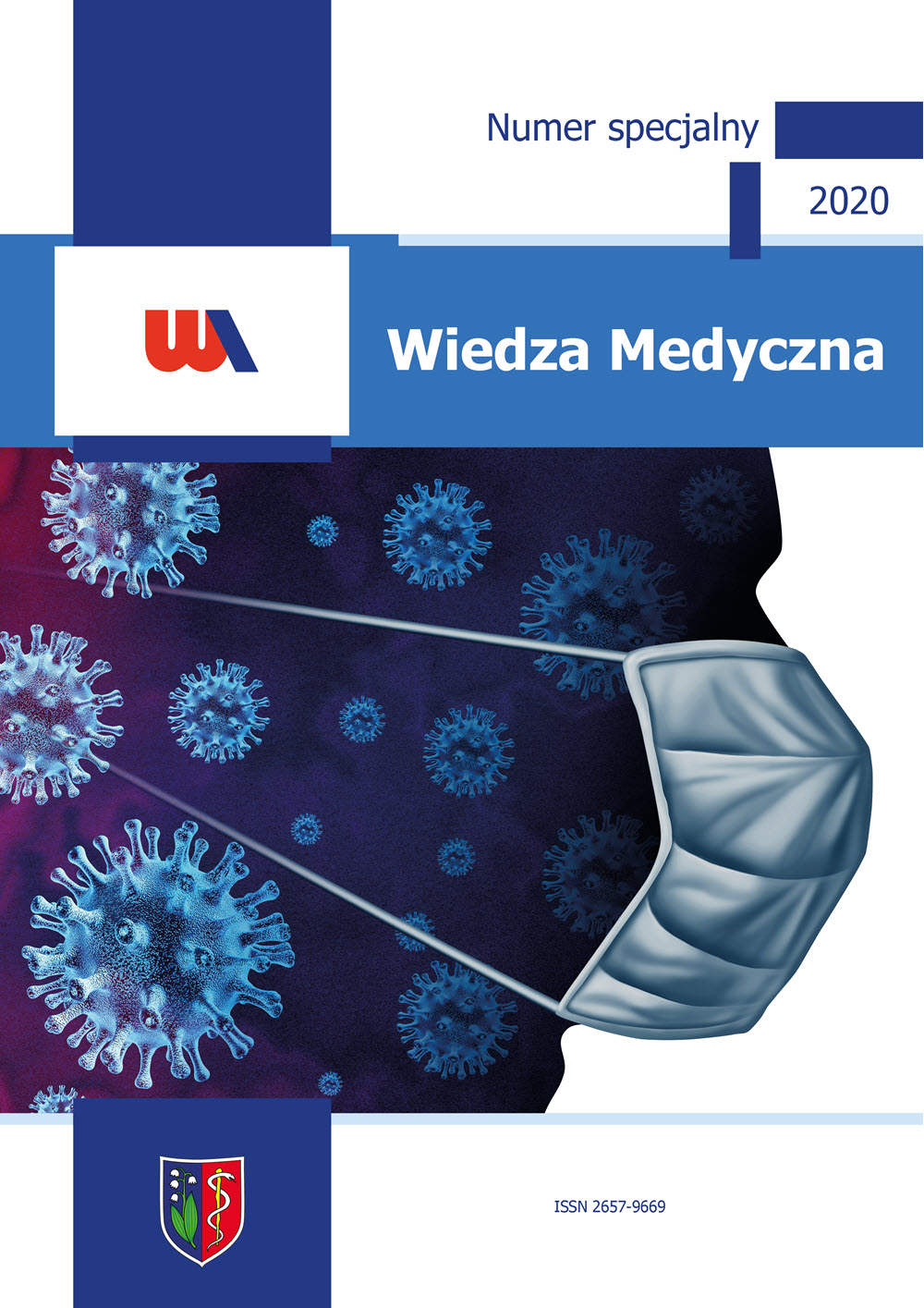Abstract
Personnel protection with the personal equipment providing physical barrier is one of the critical elements of epidemic countermeasures. The limited resource of qualified specialists: paramedics, physicians, nurses and diagnosticians makes safety of their operations an indispensable element of maintaining the continuity of the healthcare system during the epidemic. A rational selection of measures cannot compromise security and should be based on the scientific evidence. At the same time, work ergonomics and costs as well as surge wave demand and supply chain instability must be taken into account. The goal of this study is presentation of the current international guidelines (WHO, ECDC), assessment of the actual risk range for medical personnel, other crucial public services and essential business as well as the general population. We argue that adequate staff training and general public education on the ways of personal protection tailored to the risk level allow for the rational use of limited resources and flexible response to the changing situation.
References
Pathogen Safety Data Sheets: Infectious Substances – Human Coronavirus. Public Health Agency of Canada; Kanada 2010.
Pathogen Safety Data Sheets: Infectious Substances – Middle east respiratory syndrome (MERS) – related Coronavirus. Public Health Agency of Canada; Kanada 2019.
Pathogen Safety Data Sheets: Infectious Substances – Severe acute respiratory syndrome (SARS) associated coronavirus. Public Health Agency of Canada, Kanada 2019.
van Doremalen N, Bushmaker T, Morris DH, Holbrook MG, Gamble A, Williamson BN, Tamin A, Harcourt JL, Thornburg NJ, Gerber SI, Lloyd-Smith JO, de Wit E, Munster VJ. Aerosol and Surface Stability of SARS-CoV-2 as Compared with SARS-CoV-1. N Engl J Med; 2020 Mar 17. DOI:10.1056/NEJMc2004973. [Epub ahead of print] PubMed PMID: 32182409.
Moriarty LF, Plucinski MM, Marston BJ, et al. Public Health Responses to COVID-19 Outbreaks on Cruise Ships – Worldwide, February-March 2020. MMWR Morb Mortal Wkly Rep. ePub; 23 March 2020. DOI: http://dx.doi.org/10.15585/mmwr.mm6912e3external icon.
Zou L, Ruan F, Huang M, et al. SARS-CoV-2 viral load in upper respiratory specimens of infected patients N Engl J Med 2020; 382:1177‑1179. DOI:10.1056/NEJMc2001737.
Bai Y, Yao L, Wei T, Tian F, Jin DY, Chen L, Wang M. Presumed Asymptomatic Carrier Transmission of COVID-19. JAMA. 2020 Feb 21. DOI:10.1001/jama.2020.2565. [Epub ahead of print] PubMed PMID: 32083643; PubMed Central PMCID: PMC7042844.
Zhou F, Yu T, Du R, Fan G, Liu Y, Liu Z, Xiang J, Wang Y, Song B, Gu X, Guan L, Wei Y, Li H, Wu X, Xu J, Tu S, Zhang Y, Chen H, Cao B. Clinical course and risk factors for mortality of adult inpatients with COVID-19 in Wuhan, China: a retrospective cohort study. Lancet. 2020 Mar 11. pii: S0140‑6736 (20)30566‑3. DOI:10.1016/S0140‑6736 (20)30566‑3. [Epub ahead of print] Erratum in: Lancet. 2020 Mar PubMed PMID: 32171076.
van Doremalen N, Bushmaker T, Morris DH, Holbrook MG, Gamble A, Williamson BN, Tamin A, Harcourt JL, Thornburg NJ, Gerber SI, Lloyd-Smith JO, de Wit E, Munster VJ. Aerosol and Surface Stability of SARS-CoV-2 as Compared with SARS-CoV-1. N Engl J Med. 2020 Mar 17. DOI:10.1056/NEJMc2004973. [Epub ahead of print] PubMed PMID: 32182409.
www.inkstonenews.com/health/medical-journal-retracts-study-how-far-coronavirus-can-spread-through-droplets/article/3074449 [dostęp z dn. 05.04.2020 r.].
Pathogen Safety Data Sheets: Infectious Substances – Human Coronavirus, Public Health Agency of Canada; Kanada 2010.
WHO Laboratory biosafety guidance related to coronavirus disease 2019 (COVID-19) Interim guidance, 12 February 2020. World Health Organization 2020 (CC BY-NC-SA 3.0 IGO licence).
Kampf G, Todt D, Pfaender S, Steinmann E. Persistence of coronaviruses on inanimate surfaces and their inactivation with biocidal agents. J Hosp Infect. 2020;104 (3):246-251. DOI:10.1016/j.jhin.2020.01.022.
Duan SM, Zhao XS, Wen RF, Huang JJ, Pi GH, Zhang SX, Han J, Bi SL, Ruan L, Dong XP; SARS Research Team. Stability of SARS coronavirus in human specimens and environment and its sensitivity to heating and UV irradiation. Biomed Environ Sci. 2003 Sep;16 (3):246‑55. PubMed PMID: 14631830.
Rozporządzenie Ministra Zdrowia z dnia 22 kwietnia 2005 roku w sprawie szkodliwych czynników biologicznych dla zdrowia w środowisku pracy oraz ochrony zdrowia pracowników zawodowo narażonych na te czynniki (Dz. U. Nr 81 poz. 716 z późn. zm.).
Joob B, Wiwanitkit V, COVID-19 in medical personnel: observation from Thailand, Journal of Hospital Infection, https://doi.org/10.1016/j.jhin.2020.02.016.
Chang L, Yan Y, Wang L. Coronavirus Disease 2019: Coronaviruses and Blood Safety, Transfusion Medicine Reviews, https://doi.org/10.1016/j.tmrv.2020.02.003 [dostęp z dn. 05. 04. 2020 r.].
WHO Rational use of personal protective equipment for coronavirus disease 2019 (COVID-19). Interim guidance 27 February 2020. WHO 2020 (CC BY-NC-SA 3.0 IG).
European Centre for Disease Prevention and Control. Guidance for wearing and removing personal protective equipment in healthcare settings for the care of patients with suspected or confirmed COVID-19. Stockholm: ECDC; 2020.
Bielawska-Drózd A, Michalski A, Cieślik P, Makowski P, Kocik J. Metody diagnostyki laboratoryjnej COVID-19. Wiedza Medyczna 2020; 1-9. Michalski A, Bielawska-Drózd A, Pinkas J, Kocik J. Ochrona dróg oddechowych przed zagrożeniami biologicznymi – zmiana paradygmatu wobec masywnej transmisji SARS-CoV-2. Wiedza Medyczna 2020; 38-45.
Ustawa z dnia 19 sierpnia 2011 r. o przewozie towarów niebezpiecznych (Dz. U. 2011 Nr 227 poz. 1367 z póź. zm.).
Guidance on regulations for the transport of infectious substances 2019-2020. Geneva: World Health Organization; 2019 (WHO/WHE/CPI/2019.20). (CC BY-NC-SA 3.0 IGO).
Ustawa z dnia 14 grudnia 2012 r. o odpadach (Dz. U. 2013 poz. 21 z późn. zm.) oraz akty wykonawcze.
Rozporządzenie Ministra Zdrowia z dnia 5 października 2017 r. w sprawie szczegółowego sposobu postępowania z odpadami medycznymi (Dz. U. 2017 poz. 1975).
European Centre for Disease Prevention and Control. Guidance for wearing and removing personal protective equipment in healthcare settings for the care of patients with suspected or confirmed COVID-19. Stockholm: ECDC; 2020.
European Centre for Disease Prevention and Control. Personal protective equipment (PPE) needs in healthcare settings for the care of patients with suspected or confirmed 2019-nCoV. ECDC: Stockholm; 2020.

